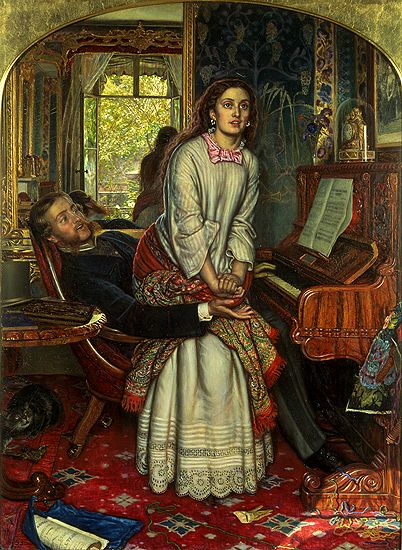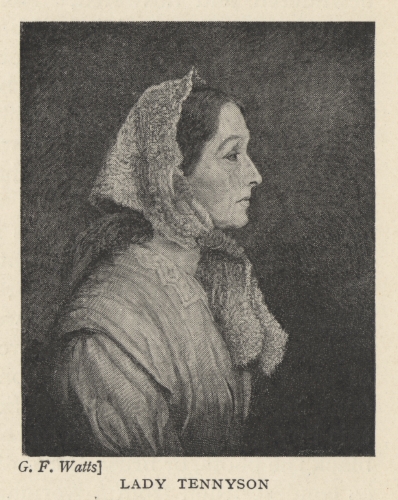The Portrayal of the Cloistered Victorian Woman
Shabnam Yusufzai and Sue Chun
1376
|
From the Lady’s hair to her loom, Hunt employs various elements of artistic detail to provide indication to the Lady’s moral condition- a fallen woman. The very room that secludes her from the outside world is filled with images that allude to Hunt’s own interpretative tale which Hunt himself stated to be “the failure of a human Soul towards its accepted responsibility”.@Shuli Barzilai, "Say That I had a Lovely Face": The Gimms' "Rapunzel," Tennyson's "Lady of Shalott," and Atwood's Lady Oracle." Tulsa Studies in Women's Literature 19.2 (2000): 242.
This statement can be seen to hold implication to an aspect of Hunt’s personal life, when he had rescued a young woman from the London slums. Her name was Annie Miller, and Hunt was eager to transform her into a “submissive creature” while keeping in mind, the goal of marriage.@Sharyn R. Udall. “Between Dream and Shadow: William Holman Hunt’s “Lady of Shalott”.” Woman’s Art Journal 11.1 (1990): 36. Woman’s Art Inc. Web. 2 Feb. 2011. < http://www.jstor.org/stable/1358385>. She was the model for Hunt’s 1853 painting, The Awakening Conscience, which is also widely considered to be a prologue for his 1857 version of the Lady of Shalott@Sharyn R. Udall. “Between Dream and Shadow: William Holman Hunt’s “Lady of Shalott”.” Woman’s Art Journal 11.1 (1990): 36. Woman’s Art Inc. Web. 2 Feb. 2011. < http://www.jstor.org/stable/1358385>. . |
The Awakening Conscience is an image that mirrors Hunt’s redemption of
Miller.@Sharyn R. Udall. “Between Dream and Shadow: William Holman Hunt’s “Lady of Shalott”.” Woman’s Art Journal 11.1 (1990): 36. Woman’s Art Inc. Web. 2 Feb. 2011. < http://www.jstor.org/stable/1358385>.
The woman in the image is also a “fallen” woman who looks directly at the viewer in a horrified manner. There is an unraveled embroidery on the floor with loose threads which is similar to the concept in Lady of Shalott. The difference however, is that the woman in this image seems to be on the verge of picking up the unravelled embroidery – which suggests that she is able to redeem her fallen moral identity. As mentioned earlier, the threads signify a web of patriarchal ideologies.@ Therefore, the woman is essentially redeeming herself by conforming to the patriarchal ideologies she once had lost a hold of. Hunt however, was betrayed by Miller when she defied his instructions.@Sharyn R. Udall. “Between Dream and Shadow: William Holman Hunt’s “Lady of Shalott”.” Woman’s Art Journal 11.1 (1990): 36. Woman’s Art Inc. Web. 2 Feb. 2011. < http://www.jstor.org/stable/1358385>.
Hunts 1857 version of Lady of Shalott can be seen to allude to this betrayal. Miller’s untameable character is reflected in the Lady, who unlike the woman in The Awakening Conscience is permanently doomed. While the woman in his 1853 painting is caught as she is crouching down to retrieve her tapestry, the Lady of his 1857 version, as well as his final 1905 version, is desperately trying to free herself from the threads that are binding her. The Lady’s deadly fate makes it impossible for her to redeem her fallen state.@Thomas L. Jeffers. "TENNYSON'S LADY OF SHALOTT AND PRE-RAPHAELITE RENDERINGS: STATEMENT AND COUNTER-STATEMENT." Religion & the Arts 6.3 (2002): 231-256. Academic Search Premier. EBSCO. Web. 2 Feb. 2011.
The woman in the image is also a “fallen” woman who looks directly at the viewer in a horrified manner. There is an unraveled embroidery on the floor with loose threads which is similar to the concept in Lady of Shalott. The difference however, is that the woman in this image seems to be on the verge of picking up the unravelled embroidery – which suggests that she is able to redeem her fallen moral identity. As mentioned earlier, the threads signify a web of patriarchal ideologies.@ Therefore, the woman is essentially redeeming herself by conforming to the patriarchal ideologies she once had lost a hold of. Hunt however, was betrayed by Miller when she defied his instructions.@Sharyn R. Udall. “Between Dream and Shadow: William Holman Hunt’s “Lady of Shalott”.” Woman’s Art Journal 11.1 (1990): 36. Woman’s Art Inc. Web. 2 Feb. 2011. < http://www.jstor.org/stable/1358385>.
Hunts 1857 version of Lady of Shalott can be seen to allude to this betrayal. Miller’s untameable character is reflected in the Lady, who unlike the woman in The Awakening Conscience is permanently doomed. While the woman in his 1853 painting is caught as she is crouching down to retrieve her tapestry, the Lady of his 1857 version, as well as his final 1905 version, is desperately trying to free herself from the threads that are binding her. The Lady’s deadly fate makes it impossible for her to redeem her fallen state.@Thomas L. Jeffers. "TENNYSON'S LADY OF SHALOTT AND PRE-RAPHAELITE RENDERINGS: STATEMENT AND COUNTER-STATEMENT." Religion & the Arts 6.3 (2002): 231-256. Academic Search Premier. EBSCO. Web. 2 Feb. 2011.
Alfred Lord Tennyson’s own upbringing and history may be a contributing factor towards why he wrote the poems he did and specifically towards his views on the role of women. Tennyson was born on August 6, 1809 at Somersby Lincolnshire and he was the fourth child out of twelve children.@Glenn Everett. "Alfred Lord Tennyson: A Brief Biography." 30 Nov. 2004. The Victorian Web. 24 Mar. 2011. Compared to his wealthy Aunt Elizabeth Russell and Uncle Charles Tennyson, Tennyson felt poor growing up and became very worrisome about his finances throughout his life. In fact, Tennyson’s anxieties about money became a reality in the late 1830’s when he invested all his inheritance into a mass-producing wood craving business and eventually became bankrupt. Due to his impoverish status, Tennyson postponed his engagement to Emily Sellwood, a woman he has known since childhood.@Marysa Demoor. "His way is thro' Chaos and the Bottomless and Pathless": The Gender of Madness in Alfred Tennyson's Poetry." Neophilologus 86.2 (2002): 325. Research Library. ProQuest. Web. 24 Mar. 2011. This shows Tennyson’s role as a man to be the financial provider in the relationship, seeing as he could not afford to marry Emily. However, in the same year, Tennyson was appointed Poet Laureate (1850) he gained financial wealth and success and thus was able to marry Emily. Furthermore, a letter obtained from The Letters of Alfred Lord Tennyson collection@Alfred Tennyson to William Bodham Donne, February 1854, Letter79 in The Letters of Alfred Lord Tennyson: Electronic edition. reveals an insight into the marriage of Alfred Tennyson and Emily Sarah Tennyson. This letter was written on February 1854 and was addressed to William Bodham Donne who wrote for several quarterlies in the 19th century and served as the chief librarian of the London Library in 1852.@"William Bodham Donne- Essayist". Web. 24 Mar. 2011. Tennyson is seeking novels about King Arthur from Donne and he is doing so at the request of his wife, Emily. Similar to her husband, Emily had a keen interest in the late great King and wished for Tennyson to write about him. The manner in which Tennyson speaks about his wife and obliges her request shows his caring nature towards women and most importantly his wife. This letter personalizes Tennyson as a husband abiding by his wife rather than a poet. Although, Tennyson is obliging his wife’s request, he is still fulfilling the conventional gender roles that were required of Victorian men and women. Tennyson is writing for Emily and communicating with the outside world, while Emily can not make this request on her own. This is reflective of the traits of the cloistered woman in Tennyson’s poem, “The Lady of Shalott” who does not interact in the public realm that belongs to men. In a sense, art is imitating life here, seeing as Emily does not have the autonomy to write the letter herself, thus her husband must communicate with the outside world in order to fulfill her request. This letter ultimately reveals that although Tennyson loves and respects his wife, the 19th century ideologies are still deeply embedded within their society that condemns conventional gender roles.
Another significant aspect of Tennyson’s history involves his consistent fear of succumbing to mental illness. Tennyson’s family has a deep rooted history with madness and therefore he believed the disease to be hereditary. Tennyson’s own paranoia over mental illness could explain the common theme of insanity that is presented in many of his poems and arguably “The Lady of Shalott”. Furthermore, many of Tennyson’s poems not only portray the theme of madness but also connect the disease to femininity. For example, the fear of insanity is Tennyson’s own internal anxieties but yet he selects female protagonists in several of his poems, such as “Mariana” and “The Princess”, to represent the “mad woman”.@ Tennyson is distancing himself personally from his poems by portraying the “mad woman” instead of the “mad man”. Tennyson believed that in order to fight the illness he must study the disease in other people and to write about it through his poetry. For example, it can be argued that the “The Lady of Shalott’s” succumbs to madness due to her isolation in the tower and seclusion from the outside world. The notion of entrapment, femininity, and madness are in direct connection to the common theme of The Mad Woman in the Attic Syndrome which derives from Charlotte Bronte’s, Jane Eyre. For example, some signs of madness arise in the Lady when she escapes the tower and finds a boat, while singing an eerie song until the very last minute she dies.
Heard a charol, mournful, holy”
“chanted loudly, chanted lowly
till her blood frozen slowly”. (II. 145-147)
The “Lady of Shalott’s” punishment for gazing at Sir Lancelot is ultimately death. Victorian women were expected to remain virginal and pure and according to gender assumptions, the Lady violates this rule. As a result, Victorian women who did not abide by these gender roles were marginalized in society. Tennyson stigmatizes Victorian woman who did not follow these conventional Victorian ideals as “mad”, in order to deflect attention away from the problems within his own society and the institution.
Heard a charol, mournful, holy”
“chanted loudly, chanted lowly
till her blood frozen slowly”. (II. 145-147)
The “Lady of Shalott’s” punishment for gazing at Sir Lancelot is ultimately death. Victorian women were expected to remain virginal and pure and according to gender assumptions, the Lady violates this rule. As a result, Victorian women who did not abide by these gender roles were marginalized in society. Tennyson stigmatizes Victorian woman who did not follow these conventional Victorian ideals as “mad”, in order to deflect attention away from the problems within his own society and the institution.
Both Tennyson's "The Lady of Shalott" and Hunt's Lady of Shalott are expressions of the author and artist's own personal views on the cloistered Victorian woman. While Tennyson's Lady reinforced the ideal characteristics of the Victorian woman, Hunt's Lady is subversive to these conventional female roles. Although Tennyson disapproved of Hunt's 1905 painting, the painting is not an illustration of Tennyson's work, but rather a separate tale set in the context of Tennyson's poem. Both Author and Artist's works - in a sense - shed light on the emerging progressive role of Victorian women in their society.




